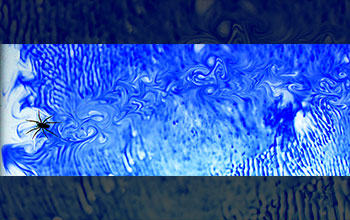Multimedia Gallery
Water spider runs along the water's surface leaving vortices behind
A freshwater spider (Dolomedes) runs along the water's surface, leaving vortices behind its four pairs of stroking legs. Dye studies were performed in order to determine what the propulsion mechanism is of water striders, a common water-walking insect.
More about this Image
Water striders (Gerris remigis) are common water-walking insects approximately 1 centimeter long that resides on the surface of ponds, rivers and the open ocean. In the past, it was believed that water striders developed momentum using the tiny waves they generate as they flap their legs across the water's surface. This was because striders move so quickly that all you see is the waves. But baby water striders legs are not big enough to generate waves, and therefore should be incapable of propelling themselves along the surface. So how are they able to move?
Enter John W.M. Bush, a mathematician from the Massachusetts Institute of Technology (MIT), and his team of researchers who, using high-speed video and blue-dyed water, tracked the movement of water striders. Bush's high-speed images and dye studies show that the water strider propels itself by driving its central pair of legs in a sculling motion. In order for it to move, it must transfer momentum to the underlying fluid. Previously it was assumed that this transfer occured exclusively through capillary waves excited by the leg stroke, but Bush and his team found that, conversely, the strider transfers momentum to the fluid principally through dipolar vortices shed by its driving legs. The strider thus generates thrust by rowing, using its legs as oars, and the menisci beneath its driving legs as blades.
Bush received a grant from the National Science Foundation (CTS 0130465) for this project. An NSF Graduate Fellowship award supported David Hu, a graduate student who worked on the project. (Year of image: 2003)
Credit: Courtesy John Bush, MIT
Images and other media in the National Science Foundation Multimedia Gallery are available for use in print and electronic material by NSF employees, members of the media, university staff, teachers and the general public. All media in the gallery are intended for personal, educational and nonprofit/non-commercial use only.
Images credited to the National Science Foundation, a federal agency, are in the public domain. The images were created by employees of the United States Government as part of their official duties or prepared by contractors as "works for hire" for NSF. You may freely use NSF-credited images and, at your discretion, credit NSF with a "Courtesy: National Science Foundation" notation.
Additional information about general usage can be found in Conditions.
Also Available:
Download the high-resolution JPG version of the image. (3.0 MB)
Use your mouse to right-click (Mac users may need to Ctrl-click) the link above and choose the option that will save the file or target to your computer.



 All images in this series
All images in this series